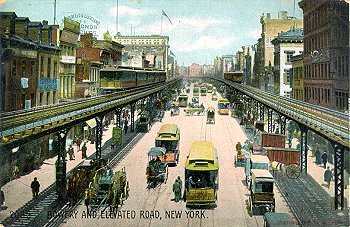N E I G H B O R S A S S O C I A T I O N ( L I N A )
t h e b o w e r y

The Bowery, the Bowery! This 1910 postcard shows the Bowery long past its heyday, but well before its present incarnation as a market for restaurant supplies and lighting fixtures. Nearly all of these buildings remain; the elevated railway tracks were torn down in the 1950s.
Low Life, Luc Sante's social history of down-and-out New York, chronicles the Bowery's long and glorious decline. Describing the street as "the proverbial den of all vices . . . the capital of dissipation . . . the main street of the lower classes . . . the forum of the slums . . . the last stop on the way down," he notes that, among the Bowery's distinctions, it is the city's only major throughfare never to have harbored a church.
The Bowery can be further explored at sites focusing on its tattoos, depravity, and homelessness. Berenice Abbot's depression-era photos of 103 Bowery and 264 Bowery offer a glimpse of the area's ragged but persistent entrepreneurialism.
The Bowery borders Little Italy to the east, running a mile from Chatham Square to Cooper Square.
They say such things and they do such things.
On the Bowery, the Bowery!
I'll never go there anymore!